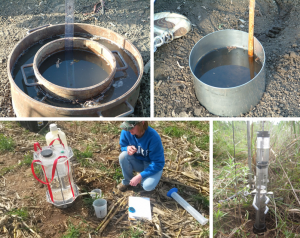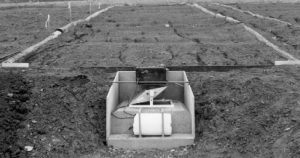6.4 Infiltration Measurements

Infiltration can be measured under controlled conditions using devices called infiltrometers. Double-ring and single-ring infiltrometers are simple metal rings pushed or pounded into the soil surface (Fig. 6‑5). Water is applied to the soil surface inside the rings either with a constant head, i.e. depth that is held constant or nearly constant by continual refilling of the ring as water infiltrates, or a falling head, i.e. the depth of ponded water is allowed to decrease over time as water infiltrates. With the single-ring infiltrometer, the infiltrating water flows laterally and vertically away from the ring, and the effects of the lateral flow must be accounted for in order to meaningfully interpret the infiltration measurements and to estimate soil properties governing infiltration, such as the soil hydraulic conductivity. The outer ring of the double-ring infiltrometer is intended to reduce lateral flow from the inner ring, allowing the data from the inner ring to be analyzed as if the flow were one-dimensional. When proper field procedures and analytical techniques are applied, both the single- and double-ring infiltrometers provide similar estimates of hydraulic conductivity [8].
Unlike ring infiltrometers which apply water to the soil surface at positive pressures, tension infiltrometers like the one shown in Fig. 6‑5 apply water under slightly negative pressures, often between -1 and -10 cm of water. Tension infiltrometers are portable, require relatively short measurement times, and require smaller volumes of water than do single- or double-ring infiltrometers. Tension infiltrometers may also result in less variable hydraulic conductivity estimates than other methods, but those estimates are, in some cases, lower than those from other methods [9].
Another type of infiltrometer, often called a sprinkle infiltrometer, applies water to the soil as drops from a collection of capillary tubes suspended a few centimeters above the surface [10]. The water delivery rate can be controlled by adjusting the pressure inside the sealed water supply reservoir and measured by the decrease of the water height in the reservoir (Fig. 6‑5). The water application continues until runoff is generated beneath the infiltrometer. The runoff is collected and measured, and the infiltration rate is calculated as the difference between the water delivery rate and the runoff rate [11].

Infiltration under natural rainfall conditions can be measured using runoff plots, which are small areas of land surrounded by borders to keep out surface runoff from adjacent areas and having equipment to collect and measure runoff on their downhill side. Infiltration can be estimated as the difference between precipitation and runoff. Fig. 6‑6 shows a runoff plot used to measure infiltration and runoff at an open-cut coal mine site in Australia [12]. When the coal mine spoils lacked vegetation, they were susceptible to raindrop impact and crust formation, which resulted in low infiltration and high runoff volumes.

